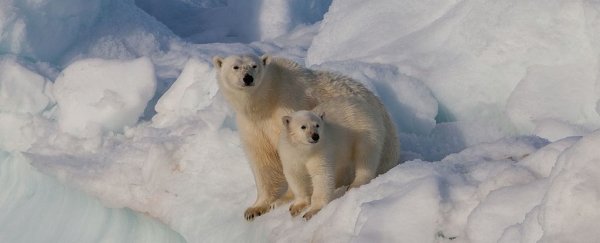Polar bears are pretty much the poster child for climate breakdown. That famous WWF photo by Carla Lombardo Ehrlich of a polar bear clinging to a remnant of melting ice is a stark and poignant image of the dangers of global warming.
A new survey suggests that in some parts of the Arctic, the polar bears' situation is not as dire as we've been fearing.
In fact, biologists have found that a previously unstudied population of polar bears (Ursus maritimus) in the Chukchi Sea, between Alaska and Russia, is actually thriving.
Before you crack open the champagne however, bear in mind that these animals aren't completely free of threat.
"This work represents a decade of research that gives us a first estimate of the abundance and status of the Chukchi Sea subpopulation," said biologist Eric Regehr of the University of Washington's Polar Science Center.
"Sea-ice loss due to climate change remains the primary threat to the species but, as this study shows, there is variation in when and where the effects of sea-ice loss appear. Some subpopulations are already declining while others are still doing OK."
Between 2008 and 2016, the Chukchi bears maintained a pretty healthy population, even though, compared to 25 years ago, they were spending around a month less on average on sea ice, the habitat the bears prefer for hunting, breeding and migrating.
In this time, the researchers tagged around 60 bears a year, some with GPS devices. According to the most recent data, the subpopulation numbered just under 3,000 individuals, with good reproductive and cub survival rates.
There are 19 subpopulations of polar bears around the world. As a whole, polar bears are officially listed as vulnerable on the IUCN Red List of Endangered Species, with an estimated 26,000 individuals worldwide; some subpopulations are declining faster than others.
For example, the subpopulation that belongs to the Southern Beaufort sea, which roams between the US and Canada, has shown evidence of decline in recent years, attributed to the declining sea ice due to climate breakdown.
Their loss of habitat has been leading to a worrying move into human-inhabited areas, and creating a credible threat to public safety.
Meanwhile the Chukchi Sea is, according to previous studies, abundant with wildlife, including seals (good meals for bears!).
"It's a very rich area. Most of the Chukchi Sea is shallow, with nutrient-rich waters coming up from the Pacific," Regehr said. "This translates into high biological productivity and, importantly for the polar bears, a lot of seals."
There are also whale carcasses that wash ashore in summer, feeding the bears in the lean months when sea ice is at its lowest.
This is in direct contrast, Regehr said, to the Southern Beaufort sea, which is nearby, but seems bereft in comparison. "It's night and day in terms of how many seals and other animals you see," he noted.
But although our world's changing climate is yet to cause a serious problem for the Chukchi region's wildlife, hints of change are starting to appear. The fact that the bears are spending less time on the ice is a cause for concern.
We also know that Arctic sea ice is melting. North of Greenland, the oldest and thickest of the Arctic sea ice has been found breaking up for the first time on record. And recent NASA research has found that over half the Arctic's permanent sea ice has been lost since 1958.
"These findings are good news for now, but it doesn't mean that bears in the Chukchi Sea won't be affected by ice loss eventually," Regehr said.
"Polar bears need ice to hunt seals, and the ice is projected to decline until the underlying problem of climate change is addressed."
The team's research has been published in the journal Scientific Reports.
